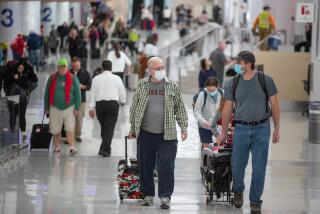Malfunction Slows Down Air Traffic Controllers
A malfunctioning computer has forced federal air traffic controllers at El Toro to use outdated methods of directing flights for the past two weeks, but Federal Aviation Administration officials said Friday that Orange County’s air safety has not been compromised.
By late Friday, the system seemed to be working without incident and may be fixed, said Marion Davis, manager of the FAA’s Coast Terminal Radar Approach Control facility, which handles 3,000 square miles of airspace, roughly from Oceanside to Torrance.
The facility, which is based at the El Toro Marine Air Station, directs traffic from John Wayne Airport, the Marines’ El Toro and Tustin air stations and from airports in Fullerton, Long Beach, Los Alamitos and Torrance.
Davis would not allow a Times reporter to interview any of the busy facility’s 35 working controllers Friday. But he described the computer problem, which began March 31, as a “distraction” and not a safety hazard. “There was no danger, no safety being derogated and no appreciable delays in and out of Orange County airports,” Davis said.
For the duration of the problem, controllers’ radar screens have continued to display moving aircraft properly, showing small green blips moving into or out of traffic sectors, said the FAA facility’s assistant manager, Irvin Vodovoz.
Information Would Freeze
But because of a malfunction in the facility’s Univac computer, from time to time “alphanumeric” information normally displayed next to a moving plane, showing flight number, altitude and speed, would suddenly freeze on the screen without updating, Vodovoz said.
This additional information is also available for each flight on a small piece of paper known as a “script” that is generated by Teletype. When the Univac computer goes down, the controller has to take his eyes off the radar screen briefly to look at the printed information, Vodovoz said.
The computer also automatically “hands off” one plane to another controller as it moves into a new radar sector, Vodovoz said, but when the computer malfunctions, a controller has to make a telephone call to complete the “handoff.”
Such outages have generally lasted from a few seconds to two minutes, Vodovoz said. However, the computer has been down for as long as two hours during repair periods, he said.
When outages occur, controllers have resorted to systems of directing traffic that they used before 1971 when the FAA first got its Univacs, Davis and Vodovoz both said. This has been an inconvenience, they said, but only that. “All controllers are trained for automation failure. We’re not going to kill anybody,” Davis said.
“It’s as if you were working with a computer that had spell-checking, and the spell-checker kept dropping the ‘e’ on the word ‘the,’ ” he explained. “It’s not a major inconvenience.”
Vodovoz added, “If you’ve got an automatic windshield washer (for your car) and it wasn’t working, you might pull over to the side and stop and get out a rag.” He said controllers had learned to anticipate the prospect of an outage and thus have been handling slightly fewer airplanes at a time and have been prepared to look at their printed flight information.
FAA repair crews have been working on the computer since it began malfunctioning March 31, and specialists from Atlantic City, N.J., arrived April 10.
After an all-night repair session, the intermittent outages appeared to have stopped Friday, Davis said. He said that an overheated processor, part of the computer’s hardware, may be the source of the problem. But he was not entirely convinced that all the bugs were out.
“Oh, they’re very optimistic, but I’ve seen that before,” he said.
More to Read
Sign up for Essential California
The most important California stories and recommendations in your inbox every morning.
You may occasionally receive promotional content from the Los Angeles Times.










